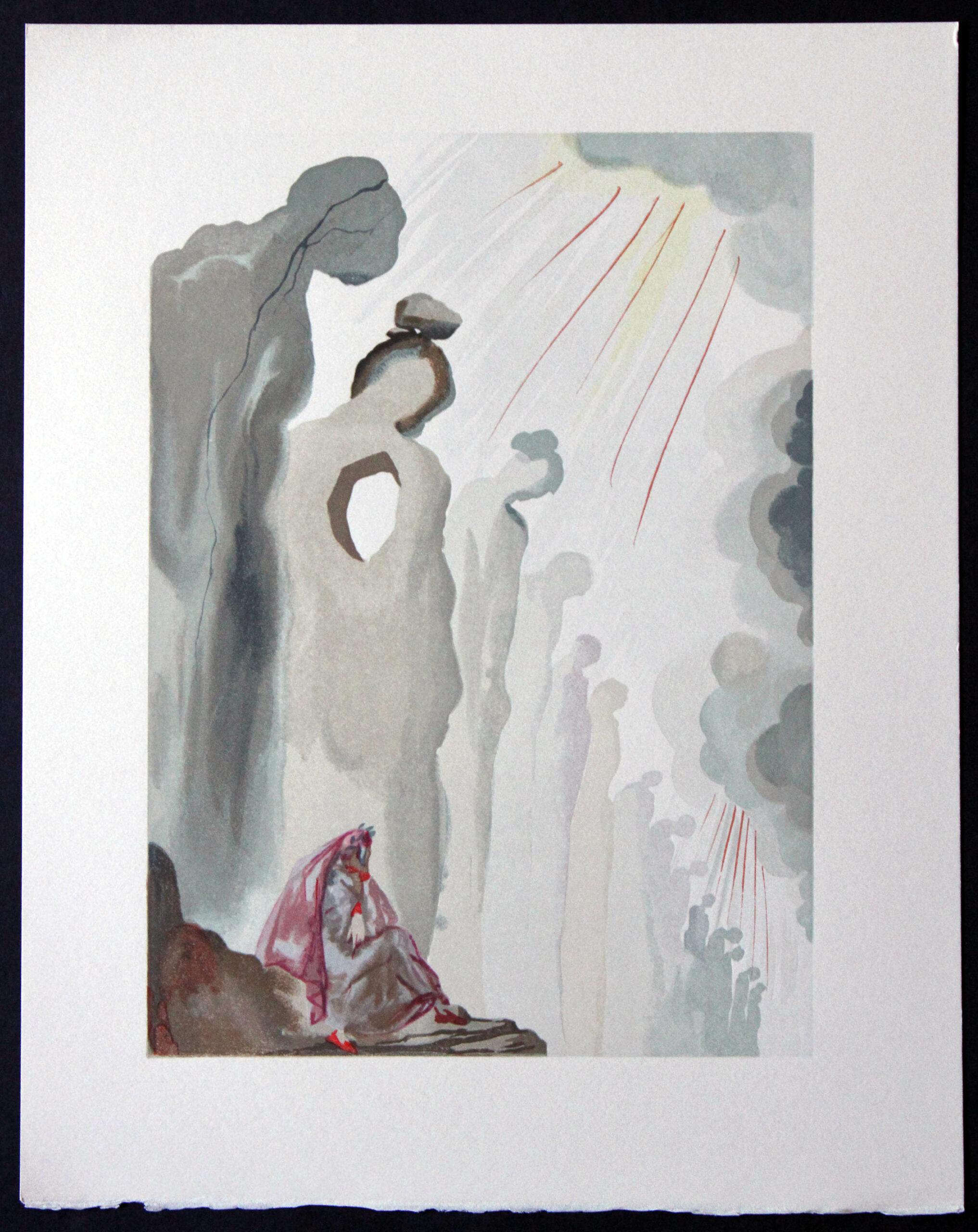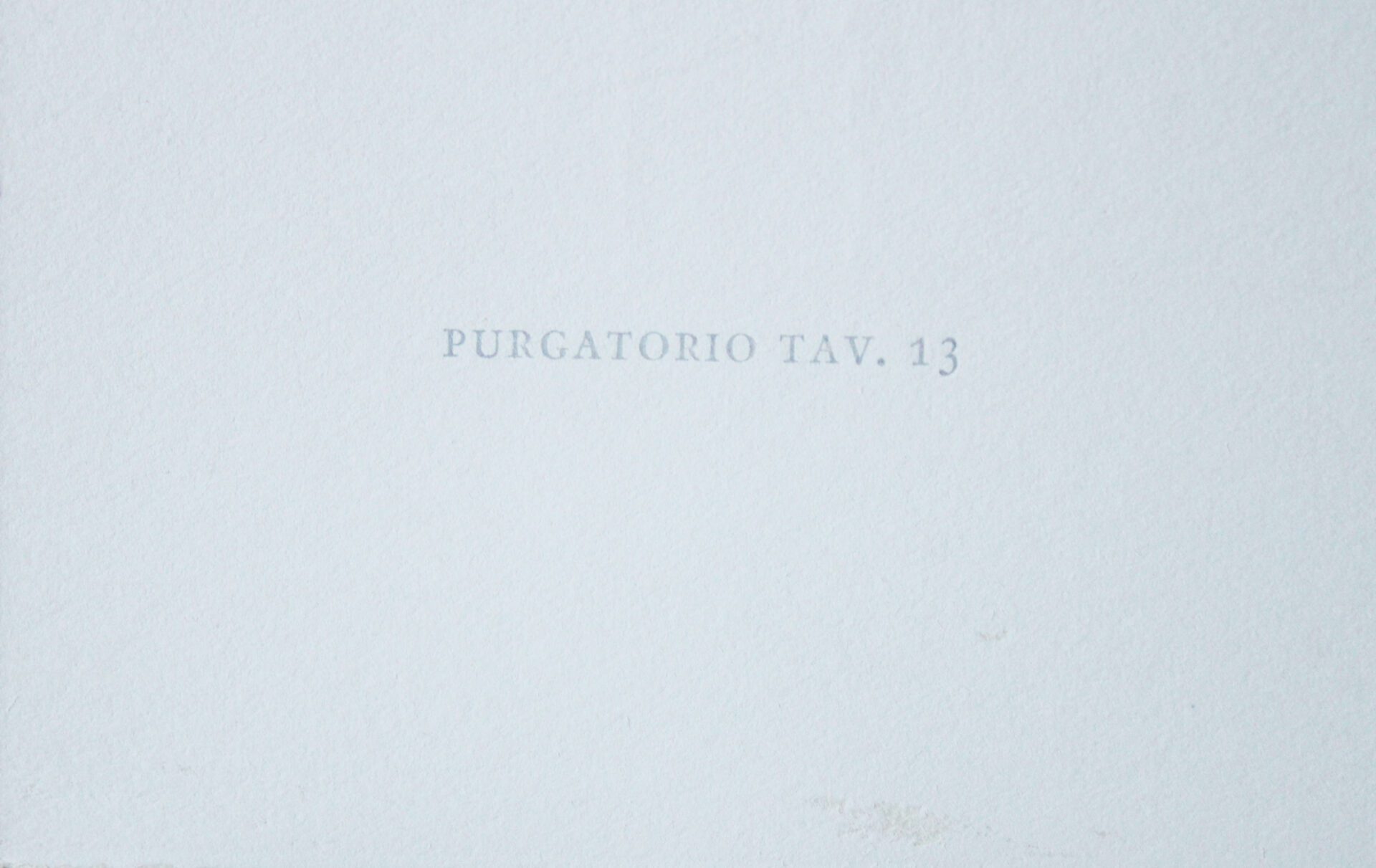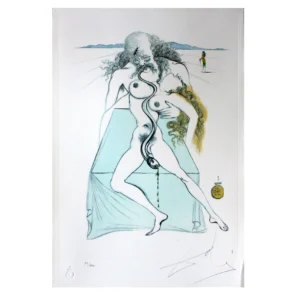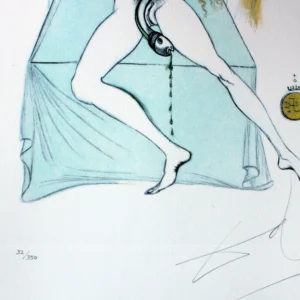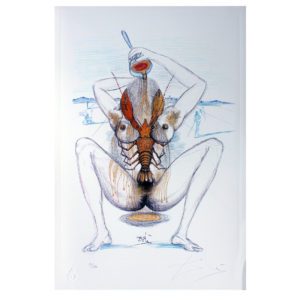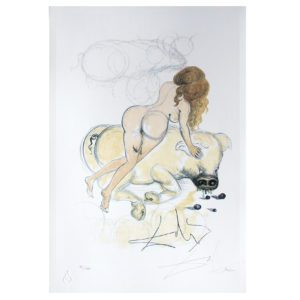Description
Salvador Dalí was born on 11 May 1904, at 8:45 am, on the first floor of Carrer Monturiol, 20 in the town of Figueres, in the Empordà region, close to the French border in Catalonia, Spain. Dalí’s older brother, who had also been named Salvador (born 12 October 1901), had died of gastroenteritis nine months earlier, on 1 August 1903. His father, Salvador Rafael Aniceto Dalí Cusí (1872–1950) was a middle-class lawyer and notary, an anti-clerical atheist and Catalan federalist, whose strict disciplinary approach was tempered by his wife, Felipa Domènech Ferrés (1874–1921), who encouraged her son’s artistic endeavors. In the summer of 1912, the family moved to the top floor of Carrer Monturiol 24 (presently 10). Dalí later attributed his “love of everything that is gilded and excessive, my passion for luxury and my love of oriental clothes” to an “Arab lineage”, claiming that his ancestors were descendants of the Moors. Dalí was haunted by the idea of his dead brother throughout his life, mythologizing him in his writings and art. Dalí said of him, “[we] resembled each other like two drops of water, but we had different reflections.” He “was probably the first version of myself but conceived too much in the absolute”. Images of his brother would reappear in his later works, including Portrait of My Dead Brother (1963). Dalí also had a sister, Anna Maria, who was three years younger. In 1949, she published a book about her brother, Dalí as Seen by His Sister. His childhood friends included future FC Barcelona footballers Sagibarba and Josep Samitier. During holidays at the Catalan resort of Cadaqués, the trio played football together. Dalí attended the Municipal Drawing School at Figueres in 1916 and also discovered modern painting on a summer vacation trip to Cadaqués with the family of Ramon Pichot, a local artist who made regular trips to Paris. The next year, Dalí’s father organized an exhibition of his charcoal drawings in their family home. He had his first public exhibition at the Municipal Theatre in Figueres in 1918, a site he would return to decades later. In early 1921 the Pichot family introduced Dalí to Futurism and Dalí’s uncle Anselm Domènech, who owned a bookshop in Barcelona, supplied him with books and magazines on Cubism and contemporary art. On 6 February 1921, Dalí’s mother died of uterine cancer. Dalí was 16 years old and later said his mother’s death “was the greatest blow I had experienced in my life. I worshipped her… I could not resign myself to the loss of a being on whom I counted to make invisible the unavoidable blemishes of my soul.” After his wife’s death, Dalí’s father married her sister. Dalí did not resent this marriage, because he had great love and respect for his aunt.
In 1929, Dalí collaborated with Surrealist film director Luis Buñuel on the short film Un Chien Andalou (An Andalusian Dog). His main contribution was to help Buñuel write the script for the film. Dalí later claimed to have also played a significant role in the filming of the project, but this is not substantiated by contemporary accounts. In August 1929, Dalí met his lifelong muse and future wife Gala, born Elena Ivanovna Diakonova. She was a Russian immigrant ten years his senior, who at that time was married to Surrealist poet Paul Éluard. In works such as The First Days of Spring, The Great Masturbator and The Lugubrious Game Dalí continued his exploration of the themes of sexual anxiety and unconscious desires. Dalí’s first Paris exhibition was at the recently opened Goemans Gallery in November 1929 and featured eleven works. In his preface to the catalog, André Breton described Dalí’s new work as “the most hallucinatory that has been produced up to now”. The exhibition was a commercial success but the critical response was divided. In the same year, Dalí officially joined the Surrealist group in the Montparnasse quarter of Paris. The Surrealists hailed what Dalí was later to call his paranoiac-critical method of accessing the subconscious for greater artistic creativity. Meanwhile, Dalí’s relationship with his father was close to rupture. Don Salvador Dalí y Cusi strongly disapproved of his son’s romance with Gala and saw his connection to the Surrealists as a bad influence on his morals. The final straw was when Don Salvador read in a Barcelona newspaper that his son had recently exhibited in Paris a drawing of the Sacred Heart of Jesus Christ, with a provocative inscription: “Sometimes, I spit for fun on my mother’s portrait”. Outraged, Don Salvador demanded that his son recant publicly. Dalí refused, perhaps out of fear of expulsion from the Surrealist group, and was violently thrown out of his paternal home on 28 December 1929. His father told him that he would be disinherited and that he should never set foot in Cadaqués again. The following summer, Dalí, and Gala rented a small fisherman’s cabin in a nearby bay at Port Lligat. He soon bought the cabin, and over the years enlarged it by buying neighboring ones, gradually building his beloved villa by the sea. Dalí’s father would eventually relent and come to accept his son’s companion. In 1931, Dalí painted one of his most famous works, The Persistence of Memory, which developed a surrealistic image of soft, melting pocket watches. The general interpretation of the work is that the soft watches are a rejection of the assumption that time is rigid or deterministic. This idea is supported by other images in the work, such as the wide expanding landscape, and other limp watches shown being devoured by ants. Dalí had two important exhibitions at the Pierre Colle Gallery in Paris in June 1931 and May–June 1932. The earlier exhibition included sixteen paintings of which The Persistence of Memory attracted the most attention. Some of the notable features of the exhibitions were the proliferation of images and references to Dalí’s muse Gala and the inclusion of Surrealist Objects such as Hypnagogic Clock and Clock Based on the Decomposition of Bodies. Dalí’s last, and largest, the exhibition at the Pierre Colle Gallery was held in June 1933 and included twenty-two paintings, ten drawings, and two objects. One critic noted Dalí’s precise draftsmanship and attention to detail, describing him as a “paranoiac of geometrical temperament”. Dalí’s first New York exhibition was held at Julien Levy’s gallery in November–December 1933. The exhibition featured twenty-six works and was a commercial and critical success. The New Yorker critic praised the precision and lack of sentimentality in the works, calling them “frozen nightmares”. Dalí and Gala, having lived together since 1929, were civilly married on 30 January 1934 in Paris. They later remarried in a Church ceremony on 8 August 1958 at Sant Martí Vell. In addition to inspiring many artworks throughout her life, Gala would act as Dalí’s business manager, supporting their extravagant lifestyle while adeptly steering clear of insolvency. Gala, who herself engaged in extra-marital affairs, seemed to tolerate Dalí’s dalliances with younger muses, secure in her own position as his primary relationship. Dalí continued to paint her as they both aged, producing sympathetic and adoring images of her. The “tense, complex and ambiguous relationship” lasting over 50 years would later become the subject of an opera, Jo, Dalí (I, Dalí) by Catalan composer Xavier Benguerel. Dalí’s first visit to the United States in November 1934 attracted widespread press coverage. His second New York exhibition was held at the Julien Levy Gallery in November–December 1934 and was again a commercial and critical success. Dalí delivered three lectures on Surrealism at the Museum of Modern Art (MoMA) and other venues during which he told his audience for the first time that “[t]he only difference between me and a madman is that I am not mad.” The heiress Caresse Crosby, the inventor of the brassiere, organized a farewell fancy dress ball for Dalí on 18 January 1935. Dalí wore a glass case on his chest containing a brassiere and Gala dressed as a woman giving birth through her head. A Paris newspaper later claimed that the Dalís had dressed as the Lindbergh baby and his kidnapper, a claim which Dalí denied. While the majority of the Surrealist group had become increasingly associated with leftist politics, Dalí maintained an ambiguous position on the subject of the proper relationship between politics and art. Leading Surrealist André Breton accused Dalí of defending the “new” and “irrational” in “the Hitler phenomenon”, but Dalí quickly rejected this claim, saying, “I am Hitlerian neither in fact nor intention”. Dalí insisted that Surrealism could exist in an apolitical context and refused to explicitly denounce fascism. Later in 1934, Dalí was subjected to a “trial”, in which he narrowly avoided being expelled from the Surrealist group. To this, Dalí retorted, “The difference between the Surrealists and me is that I am a Surrealist.” In 1936, Dalí took part in the London International Surrealist Exhibition. His lecture, titled Fantômes paranoiacs authentiques, was delivered while wearing a deep-sea diving suit and helmet. He had arrived carrying a billiard cue and leading a pair of Russian wolfhounds and had to have the helmet unscrewed as he gasped for breath. He commented that “I just wanted to show that I was ‘plunging deeply into the human mind.” Dalí’s first solo London exhibition was held at the Alex, Reid, and Lefevre Gallery the same year. The show included twenty-nine paintings and eighteen drawings. The critical response was generally favorable, although the Daily Telegraph critic wrote: “These pictures from the subconscious reveal so skilled a craftsman that the artist’s return to full consciousness may be awaited with interest.” In December 1936 Dalí participated in the Fantastic Art, Dada, Surrealism exhibition at MoMA and a solo exhibition at the Julien Levy Gallery in New York. Both exhibitions attracted large attendances and widespread press coverage. The painting Soft Construction with Boiled Beans (Premonition of Civil War) (1936) attracted particular attention. On 14 December, Dalí, aged 32, was featured on the cover of Time magazine. From 1933 Dalí was supported by Zodiac, a group of affluent admirers who each contributed to a monthly stipend for the painter in exchange for a painting of their choice. From 1936 Dalí’s main patron in London was the wealthy Edward James who would support him financially for two years. One of Dalí’s most important paintings from the period of James’ patronage was The Metamorphosis of Narcissus (1937). They also collaborated on two of the most enduring icons of the Surrealist movement: the Lobster Telephone and the Mae West Lips Sofa. Dalí was in London when the Spanish Civil War broke out in July 1936. When he later learned that his friend Lorca had been executed by Nationalist forces, Dalí’s claimed response was to shout: “Olé!” Dalí was to include frequent references to the poet in his art and writings for the remainder of his life. Nevertheless, Dalí avoided taking a public stand for or against the Republic for the duration of the conflict. In January 1938, Dalí unveiled Rainy Taxi, a three-dimensional artwork consisting of an automobile and two mannequin occupants being soaked with rain from within the taxi. The piece was first displayed at the Galerie Beaux-Arts in Paris at the Exposition Internationale du Surréalisme, organized by André Breton and Paul Éluard. The Exposition was designed by artist Marcel Duchamp, who also served as host. In March that year, Dalí met Sigmund Freud thanks to Stefan Zweig. Dalí started to sketch Freud’s portrait, while the 82-year-old celebrity confided to others: “This boy looks like a fanatic.” Dalí was delighted upon hearing later about this comment from his hero. In September 1938, Salvador Dalí was invited by Gabrielle Coco Chanel to her house “La Pausa” in Roquebrune on the French Riviera. There he painted numerous paintings he later exhibited at Julien Levy Gallery in New York. This exhibition in March–April 1939 included twenty-one paintings and eleven drawings. Life reported that no exhibition in New York had been so popular since Whistler’s Mother was shown in 1934. At the 1939 New York World’s Fair, Dalí debuted his Dream of Venus Surrealist pavilion, located in the Amusements Area of the exposition. It featured bizarre sculptures, statues, mermaids, and live nude models in “costumes” made of fresh seafood, an event photographed by Horst P. Horst, George Platt Lynes, and Murray Korman. Dalí was angered by changes to his designs, railing against mediocrities who thought that “a woman with the tail of a fish is possible; a woman with the head of a fish impossible.” Soon after Franco’s victory in the Spanish Civil War in April 1939, Dalí wrote to Luis Buñuel denouncing socialism and Marxism and praising Catholicism and the Falange. As a result, Buñuel broke off relations with Dalí. In the May issue of the Surrealist magazine Minotaure, André Breton announced Dalí’s expulsion from the Surrealist group, claiming that Dalí had espoused race war and that the over-refinement of his paranoiac-critical method was a repudiation of Surrealist automatism. This led many Surrealists to break off relations with Dalí. In 1949 Breton coined the derogatory nickname “Avida Dollars” (avid for dollars), an anagram for “Salvador Dalí”. This was a derisive reference to the increasing commercialization of Dalí’s work, and the perception that Dalí sought self-aggrandizement through fame and fortune.
World War II
The outbreak of World War II in September 1939 saw the Dalís in France. Following the German invasion, they were able to escape because on 20 June 1940 they were issued visas by Aristides de Sousa Mendes, Portuguese consul in Bordeaux, France. They crossed into Portugal and subsequently sailed on the Excambion from Lisbon to New York in August 1940. Dalí and Gala were to live in the United States for eight years, splitting their time between New York and the Monterey Peninsula, California. Dalí spent the winter of 1940–41 at Hampton Manor, the residence of Caresse Crosby, in Caroline County, Virginia, where he worked on various projects including his autobiography and paintings for his upcoming exhibition. Dalí announced the death of the Surrealist movement and the return of classicism in his exhibition at the Julien Levy Gallery in New York in April–May 1941. The exhibition included nineteen paintings (among them Slave Market with the Disappearing Bust of Voltaire and The Face of War) and other works. In his catalog essay and media comments, Dalí proclaimed a return to form, control, structure and the Golden Section. Sales however were disappointing and the majority of critics did not believe there had been a major change in Dalí’s work. Dalí was the subject of a major joint retrospective exhibition with Joan Miró at MoMA from November 1941 to February 1942, Dalí being represented by forty-two paintings and sixteen drawings. Dalí’s work attracted most of the attention of critics and the exhibition later toured eight American cities, enhancing his reputation in America. In October 1942, Dalí’s autobiography, The Secret Life of Salvador Dalí was published simultaneously in New York and London and was reviewed widely by the press. Time magazine’s reviewer called it “one of the most irresistible books of the year”. George Orwell later wrote a scathing review in the Saturday Book. A passage in the autobiography in which Dalí claimed that Buñuel was solely responsible for the anti-clericalism in the film L’Age d’Or may have indirectly led to Buñuel losing his position at MoMA in 1943. Dalí also published a novel Hidden Faces in 1944 with less critical and commercial success. In the catalog essay for his exhibition at the Knoedler Gallery in New York in 1943 Dalí continued his attack on the Surrealist movement, writing: “Surrealism will at least have served to give experimental proof that total sterility and attempts at automatizations have gone too far and have led to a totalitarian system. … Today’s laziness and the total lack of technique have reached their paroxysm in the psychological signification of the current use of the college [collage]”. The critical response to the society portraits in the exhibition, however, was generally negative. In November–December 1945 Dalí exhibited new work at the Bignou Gallery in New York. The exhibition included eleven oil paintings, watercolors, drawings, and illustrations. Works included Basket of Bread, Atomic and Uranian Melancholic Ideal, and My Wife Nude Contemplating her own Body Transformed into Steps, the Three Vertebrae of a Column, Sky and Architecture. The exhibition was notable for works in Dalí’s new classicism style and those heralding his “atomic period”. During the war years, Dalí was also engaged in projects in various other fields. He executed designs for a number of ballets including Labyrinth (1942), Sentimental Colloquy, Mad Tristan, and The Cafe of Chinitas (all 1944). In 1945 he created the dream sequence for Alfred Hitchcock’s film Spellbound. He also produced artwork and designs for products such as perfumes, cosmetics, hosiery and ties.
Post War in United States (1946–48)
In 1946 Dalí worked with Walt Disney and animator John Hench on an unfinished animated film Destino. Dalí exhibited new work at the Bignou Gallery from November 1947 to January 1948. The 14 oil paintings and other works in the exhibition reflected Dalí’s increasing interest in atomic physics. Notable works included Dematerialization Near the Nose of Nero (The Separation of the Atom), Intra-Atomic Equilibrium of a Swan’s Feather, and a study for Leda Atomica. The proportions of the latter work were worked out in collaboration with a mathematician.In early 1948 Dalí’s 50 Secrets of Magic Craftsmanship was published. The book was a mixture of practical advice on painting, and anecdotes, and Dalínian polemics.
In 1948 Dalí and Gala moved back into their house in Port Lligat, on the coast near Cadaqués. For the next three decades, they would spend most of their time there, spending winters in Paris and New York. Dalí’s decision to live in Spain under Franco and his public support for the regime prompted outrage from many anti-Francoist artists and intellectuals. Pablo Picasso refused to mention Dalí’s name or acknowledge his existence for the rest of his life. In 1960, André Breton unsuccessfully fought against the inclusion of Dalí’s Sistine Madonna in the Surrealist Intrusion in the Enchanter’s Domain exhibition organized by Marcel Duchamp in New York. Breton and other Surrealists issued a tract to coincide with the exhibition denouncing Dalí as “the ex-apologist of Hitler… and friend of Franco”. In December 1949 Dalí’s sister Anna Maria published her book Salvador Dalí Seen by his Sister. Dalí was angered by passages that he considered derogatory towards his wife Gala and broke off relations with his family. When Dalí’s father died in September 1950 Dalí learned that he had been virtually disinherited in his will. A two-year legal dispute followed over paintings and drawings Dalí had left in his family home, during which Dalí was accused of assaulting a public notary. As Dalí moved further towards embracing Catholicism he introduced more religious iconography and themes in his painting. In 1949 he painted a study for The Madonna of Port Lligat (first version, 1949) and showed it to Pope Pius XII during an audience arranged to discuss Dalí ‘s marriage to Gala. This work was a precursor to the phase Dalí dubbed “Nuclear Mysticism,” a fusion of Einsteinian physics, classicism, and Catholic mysticism. In paintings such as The Madonna of Port Lligat, The Christ of Saint John on the Cross and The Disintegration of the Persistence of Memory, Dalí sought to synthesize Christian iconography with images of material disintegration inspired by nuclear physics. His later Nuclear Mysticism works included La Gare de Perpignan (1965) and The Hallucinogenic Toreador (1968–70). Dalí’s keen interest in natural science and mathematics was further manifested by the proliferation of images of DNA and rhinoceros horn shapes in works from the mid-1950s. According to Dalí, the rhinoceros horn signifies divine geometry because it grows in a logarithmic spiral. Dalí was also fascinated by the Tesseract (a four-dimensional cube), using it, for example, in Crucifixion (Corpus Hypercubus). Dalí had been extensively using optical illusions such as double images, anamorphosis, negative space, visual puns and trompe-l’œil since his Surrealist period and this continued in his later work. At some point, Dalí had a glass floor installed in a room near his studio in Port Lligat. He made extensive use of it to study foreshortening, both from above and from below, incorporating dramatic perspectives of figures and objects into his paintings. He also experimented with the bulletist technique pointillism, enlarged half-tone dot grids and stereoscopic images. He was among the first artists to employ holography in an artistic manner. In Dalí’s later years, young artists such as Andy Warhol proclaimed him an important influence on pop art. In 1960, Dalí began work on his Theatre-Museum in his home town of Figueres. It was his largest single project and a main focus of his energy through to 1974, when it opened. He continued to make additions through the mid-1980s. In 1955 Dalí met Nanita Kalaschnikoff, who was to become a close friend, muse, and model. At a French nightclub in 1965 Dalí met Amanda Lear, a fashion model then known as Peki Oslo. Lear became his protégée and one of his muses. According to Lear, she and Dalí were united in a “spiritual marriage” on a deserted mountaintop.
In 1968, Dalí bought a castle in Púbol for Gala, and from 1971 she would retreat there for weeks at a time, Dalí having agreed not to visit without her written permission. His fears of abandonment and estrangement from his longtime artistic muse contributed to depression and failing health. In 1980, at age 76, Dalí’s health deteriorated sharply and he was treated for depression, drug addiction, and Parkinson-like symptoms, including a severe tremor in his right arm. There were also allegations that Gala had been supplying Dalí with pharmaceuticals from her own prescriptions. Gala died on 10 June 1982, at the age of 87. After her death, Dalí moved from Figueres to the castle in Púbol, where she was entombed. In 1982, King Juan Carlos bestowed on Dalí the title of Marqués de Dalí de Púbol (Marquess of Dalí of Púbol) in the nobility of Spain, Púbol being where Dalí then lived. The title was initially hereditary, but at Dalí’s request was changed to life-only in 1983. In May 1983, what was said to be Dalí’s last painting, The Swallow’s Tail, was revealed. The work was heavily influenced by the mathematical catastrophe theory of René Thom. However, some critics have questioned how Dalí could have executed a painting with such precision given the severe tremor in his painting arm. From early 1984 Dalí’s depression worsened and he refused food, leading to severe undernourishment. Dalí had previously stated his intention to put himself into a state of suspended animation as he had read that some microorganisms could do. In August 1984 a fire broke out in Dalí’s bedroom and he was hospitalized with severe burns. Two judicial inquiries found that the fire was caused by an electrical fault and no findings of negligence were made. After his release from hospital Dalí moved to the Torre Galatea, an annex to the Dalí Theatre-Museum. There have been allegations that Dalí was forced by his guardians to sign blank canvases that could later be used in forgeries. It is also alleged that he knowingly sold otherwise-blank lithograph paper which he had signed, possibly producing over 50,000 such sheets from 1965 until his death. As a result, art dealers tend to be wary of late graphic works attributed to Dalí. In July 1986, Dalí had a pacemaker implanted. On his return to his Theatre-Museum he made a brief public appearance, saying: “When you are a genius, you do not have the right to die, because we are necessary for the progress of humanity.” In November 1988, Dalí entered the hospital with heart failure. On 5 December 1988, he was visited by King Juan Carlos, who confessed that he had always been a serious devotee of Dalí. Dalí gave the king a drawing, Head of Europa, which would turn out to be Dalí’s final drawing. On the morning of 23 January 1989, while his favorite record of Tristan and Isolde played, Dalí died of heart failure at the age of 84. He is buried in the crypt below the stage of his Theatre-Museum in Figueres. The location is across the street from the church of Sant Pere, where he had his baptism, first communion, and funeral, and is only 450 metres (1,480 ft) from the house where he was born. The Gala-Salvador Dalí Foundation currently serves as his official estate. The US copyright representative for the Gala-Salvador Dalí Foundation is the Artists Rights Society.

